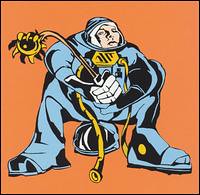Precious Jewels
Artists: Bahia Black; Tin Machine
Albums: Ritual Beating System; Tin Machine
Source: Promo (BB); Bought new (TM)
In Noah Baumbach’s movie The Squid and the Whale, there’s a scene where Jeff Daniels is examining a copy of Pink Floyd’s The Wall. The album itself would be kind of innocuous, except that it’s a tape. Yeah, a cassette tape. That one detail solidly reinforces the part of the 80s the movie is set in, because lordy knows if it was set much later, m’man would be downer-rocking The Wall on CD.
I’m about the right age to have been there when CDs hit the scene with an unbelievable force – it was kind of like one minute LPs and tapes were the only option, and then next time you blinked the mall record store was pushing the vinyl into the corner to make room for more and more CDs.
Attendant with the arrival of the discs was the jewel case. It’s easy not to think about it (what Paul Lukas calls “inconspicuous consumption” in his excellent Beer Frame ‘zine), but also impossible to escape. If you buy a CD – especially in the first days, before anyone had come up with alternatives like the Digipak – you’re also buying the subtly ingenious jewel-case storage system.
What’s so great about them? Well, for one, they roughly mimic the shape of an LP (though on a drastically reduced scale) but also have easier-to-read spines than you get on a 12-inch.They hold the disc just barely off the surface of the inner tray, protecting the bottom from extra wear. And best of all, jewel cases are modular: their component parts are interchangeable and user-replaceable. In other words, if one part of the case breaks, no sweat – you can just snap the broken part out, and snap a new one in.
Now in theory, this modularity sounds like its all upside, no downside. That might be true for the casual CD buyer, but real Music Nerds know that this swappability creates a whole ‘nother semi-hassle. See, the parts of these cases do break. And you do need to replace them. But when you replace, say, the front-cover piece of a jewel box, you’re generally taking it from another one…which now has only the back piece and the inner tray left. So you have to hold onto that, for the time when another jewel case needs a new inner tray. And even then you’ve got a perfectly good back section, which you know you’re gonna need sooner or later, so let’s not even talk about getting rid of that just yet…
And on it goes. Soon there’s a kind of Jewel Case Chop Shop running in a corner of the apartment, dead space filled with not-quite-whole cases that are destined to be farmed out to other needy CDs before long. Anyone who says perfected cloning technology won’t lead to farm-growing people for spare organs is dead wrong; the seeds have been sown with jewel cases.
Part of my system, to try and save some room, was to have some “B-list” cases: CDs that I wanted to keep but wasn’t too crazy about, so I’d switch their solid parts with an “A-list” disc’s broken ones. That way, the net number of jewel cases in The Beast wouldn’t increase; instead, some would be downgraded until, say, I was throwing out a bunch of unneeded promo CDs (which I would pillage for jewel-case parts).
Bahia Black and Tin Machine were, for a long time, my top go-to CDs for pawning off broken parts. There were times when either or both of these discs wouldn’t have a single intact section of their cases: long cracks along the back, toothless holders on the tray, both swing arms snapped off the front. The discs and cover/tray art were all there, but the once-good cases had given their lives for a damaged Yo La Tengo or John Coltrane case.
SISOSIG?Over time, this mismatched pair would keep getting new cases; soon enough, those new cases would erode. Somehow, I’d ID’d these discs as placeholders, not deserving of top-tier storage materials.
But y’know what? They took the hits, bided their time, and now I can safely say these things are off the Disabled List. Bahia Black, which sounded too far out to me in 1999, now hits my ears straight on. I’ve grown to love Bill Laswell’s approach to how world and avant-garde sounds fit together (talk about modular), and the South American rhythms of Ritual Beating System wrap around the contributions by Herbie Hancock, Wayne Shorter, Henry Threadgill and other right-on/out-there cats in a way I can’t really resist.
And Tin Machine? Turns out David Bowie was a little ahead of the curve once again – this record took some hits in 1989, with Bowie playing “band” with Soupy Sales’ kids (they’re TM’s rhythm section). But Reeves Gabrel’s distorto-freako guitar style anticipates how the Seattleites would co-opt Sonic Youth into harder, sludgier (and, yes, grungier) forms a half-decade later. The songs themselves are only 50/50, but the sound goes to 11.
Albums: Ritual Beating System; Tin Machine
Source: Promo (BB); Bought new (TM)
In Noah Baumbach’s movie The Squid and the Whale, there’s a scene where Jeff Daniels is examining a copy of Pink Floyd’s The Wall. The album itself would be kind of innocuous, except that it’s a tape. Yeah, a cassette tape. That one detail solidly reinforces the part of the 80s the movie is set in, because lordy knows if it was set much later, m’man would be downer-rocking The Wall on CD.
I’m about the right age to have been there when CDs hit the scene with an unbelievable force – it was kind of like one minute LPs and tapes were the only option, and then next time you blinked the mall record store was pushing the vinyl into the corner to make room for more and more CDs.
Attendant with the arrival of the discs was the jewel case. It’s easy not to think about it (what Paul Lukas calls “inconspicuous consumption” in his excellent Beer Frame ‘zine), but also impossible to escape. If you buy a CD – especially in the first days, before anyone had come up with alternatives like the Digipak – you’re also buying the subtly ingenious jewel-case storage system.
What’s so great about them? Well, for one, they roughly mimic the shape of an LP (though on a drastically reduced scale) but also have easier-to-read spines than you get on a 12-inch.They hold the disc just barely off the surface of the inner tray, protecting the bottom from extra wear. And best of all, jewel cases are modular: their component parts are interchangeable and user-replaceable. In other words, if one part of the case breaks, no sweat – you can just snap the broken part out, and snap a new one in.
Now in theory, this modularity sounds like its all upside, no downside. That might be true for the casual CD buyer, but real Music Nerds know that this swappability creates a whole ‘nother semi-hassle. See, the parts of these cases do break. And you do need to replace them. But when you replace, say, the front-cover piece of a jewel box, you’re generally taking it from another one…which now has only the back piece and the inner tray left. So you have to hold onto that, for the time when another jewel case needs a new inner tray. And even then you’ve got a perfectly good back section, which you know you’re gonna need sooner or later, so let’s not even talk about getting rid of that just yet…
And on it goes. Soon there’s a kind of Jewel Case Chop Shop running in a corner of the apartment, dead space filled with not-quite-whole cases that are destined to be farmed out to other needy CDs before long. Anyone who says perfected cloning technology won’t lead to farm-growing people for spare organs is dead wrong; the seeds have been sown with jewel cases.
Part of my system, to try and save some room, was to have some “B-list” cases: CDs that I wanted to keep but wasn’t too crazy about, so I’d switch their solid parts with an “A-list” disc’s broken ones. That way, the net number of jewel cases in The Beast wouldn’t increase; instead, some would be downgraded until, say, I was throwing out a bunch of unneeded promo CDs (which I would pillage for jewel-case parts).
Bahia Black and Tin Machine were, for a long time, my top go-to CDs for pawning off broken parts. There were times when either or both of these discs wouldn’t have a single intact section of their cases: long cracks along the back, toothless holders on the tray, both swing arms snapped off the front. The discs and cover/tray art were all there, but the once-good cases had given their lives for a damaged Yo La Tengo or John Coltrane case.
SISOSIG?Over time, this mismatched pair would keep getting new cases; soon enough, those new cases would erode. Somehow, I’d ID’d these discs as placeholders, not deserving of top-tier storage materials.
But y’know what? They took the hits, bided their time, and now I can safely say these things are off the Disabled List. Bahia Black, which sounded too far out to me in 1999, now hits my ears straight on. I’ve grown to love Bill Laswell’s approach to how world and avant-garde sounds fit together (talk about modular), and the South American rhythms of Ritual Beating System wrap around the contributions by Herbie Hancock, Wayne Shorter, Henry Threadgill and other right-on/out-there cats in a way I can’t really resist.
And Tin Machine? Turns out David Bowie was a little ahead of the curve once again – this record took some hits in 1989, with Bowie playing “band” with Soupy Sales’ kids (they’re TM’s rhythm section). But Reeves Gabrel’s distorto-freako guitar style anticipates how the Seattleites would co-opt Sonic Youth into harder, sludgier (and, yes, grungier) forms a half-decade later. The songs themselves are only 50/50, but the sound goes to 11.





